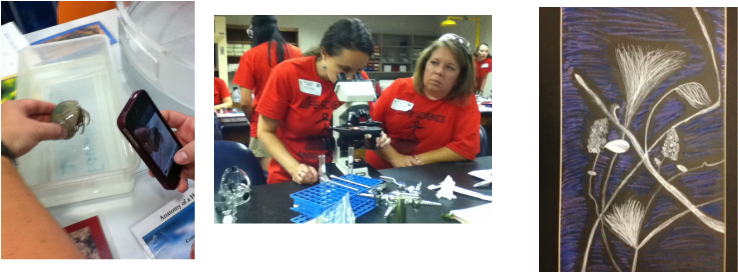Environment as a Context for Learning
Pre-kindergarten
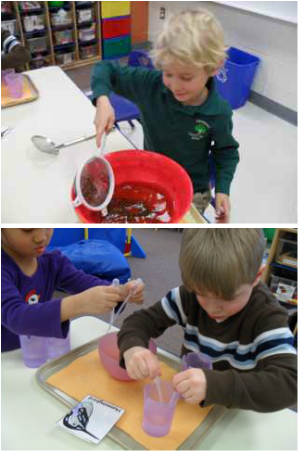
Learning About Nature
This year our pre-kindergarten teacher was trained in the Growing Up Wild Curriculum offered through the Robinson Nature Center. Growing Up Wild is an early childhood education program that builds on a children's sense of wonder about nature and invites them to explore wildlife and the world around them. Several lessons from this curriculum have been incorporated into the classroom this year including "Oh Deer", where students learn that animals need food, water, shelter and space in their habitats in order to survive.
These photos show students learning about how different birds have beaks that are designed to retrieve food. Many of the lessons in Growing Up Wild require students to be engage outside observing nature.
This year our pre-kindergarten teacher was trained in the Growing Up Wild Curriculum offered through the Robinson Nature Center. Growing Up Wild is an early childhood education program that builds on a children's sense of wonder about nature and invites them to explore wildlife and the world around them. Several lessons from this curriculum have been incorporated into the classroom this year including "Oh Deer", where students learn that animals need food, water, shelter and space in their habitats in order to survive.
These photos show students learning about how different birds have beaks that are designed to retrieve food. Many of the lessons in Growing Up Wild require students to be engage outside observing nature.
Kindergarten
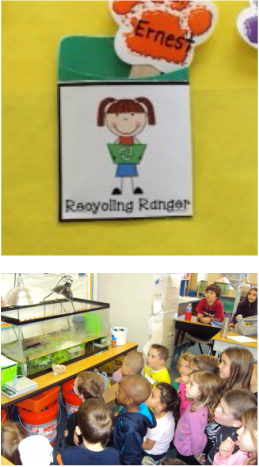
Paper Brigade
Kindergarten students worked together in small groups to learn about the benefits of Recycling, Reusing and Re-Purposing, and Reducing. The students made posters that showed their creative suggestions and innovative ways to conserve.
In the kindergarten classrooms there is a special classroom helper assigned each week to monitor the lights. Also, students are responsible for monitoring and using a color-coded recycling tote for all paper used in the classroom. They have a recycling monitor that makes sure reusable scraps are not placed in the recycling bins.
The Kindergartens also learn from the experts about our environment. A gardener and local nursery owner taught students about planting. She had the students plant seeds for flowers to take home and replant.
Every year Kindergarten students learn about water conservation, trees and other natural resources in science. Using Dr. Seuss' The Lorax to kick off discussion, the students focus on how they can conserve rather than waste natural resources. They then conduct experiments using water to learn more about this resource.
Kindergarten students worked together in small groups to learn about the benefits of Recycling, Reusing and Re-Purposing, and Reducing. The students made posters that showed their creative suggestions and innovative ways to conserve.
In the kindergarten classrooms there is a special classroom helper assigned each week to monitor the lights. Also, students are responsible for monitoring and using a color-coded recycling tote for all paper used in the classroom. They have a recycling monitor that makes sure reusable scraps are not placed in the recycling bins.
The Kindergartens also learn from the experts about our environment. A gardener and local nursery owner taught students about planting. She had the students plant seeds for flowers to take home and replant.
Every year Kindergarten students learn about water conservation, trees and other natural resources in science. Using Dr. Seuss' The Lorax to kick off discussion, the students focus on how they can conserve rather than waste natural resources. They then conduct experiments using water to learn more about this resource.
First Grade
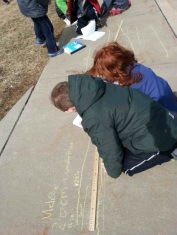
Immersed in Nature
This year, first grade will be going to the Robinson Nature Center to learn more about our natural world. They will be attending exhibits, going on nature walks, and visiting the Discovery Room. This is in conjunction with two first grade teachers who attended Environmental Workshops through the Robinson Nature Center.
Each year in March during social studies, students brainstorm ways they can help the environment. They have classroom discussions on what the word recycling means. They then draw and write about ways they can help the environment through recycling. This reflection helps them become more aware of how their actions have an impact on our environment.
First grade teacher Jennifer Lambros often teaches math lessons outside (shown left). The students have to compare measurements using inches and centimeters and then determine the differences/similarities between them. They were given specific measurements and then had to use the yardstick to draw and label their lines and then be ready to discuss what they discovered about the two different standard units used to measure.
This year, first grade will be going to the Robinson Nature Center to learn more about our natural world. They will be attending exhibits, going on nature walks, and visiting the Discovery Room. This is in conjunction with two first grade teachers who attended Environmental Workshops through the Robinson Nature Center.
Each year in March during social studies, students brainstorm ways they can help the environment. They have classroom discussions on what the word recycling means. They then draw and write about ways they can help the environment through recycling. This reflection helps them become more aware of how their actions have an impact on our environment.
First grade teacher Jennifer Lambros often teaches math lessons outside (shown left). The students have to compare measurements using inches and centimeters and then determine the differences/similarities between them. They were given specific measurements and then had to use the yardstick to draw and label their lines and then be ready to discuss what they discovered about the two different standard units used to measure.
Second Grade
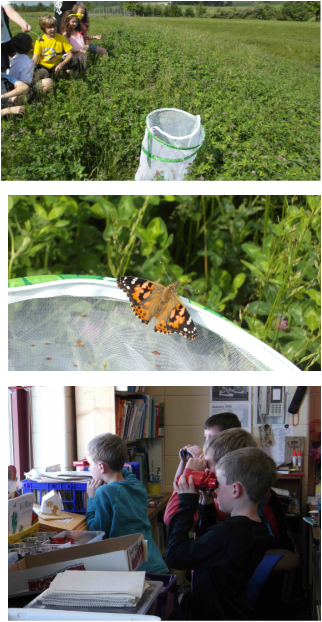
Butterfly Experts
It is a messy job, but one that second graders are willing to tackle--- learning about soil. In the fall each year, students learn about the human impact on soil erosion and develop a plan to solve an erosion problem at our school.
Second graders also study the life cycle of butterflies during 4th quarter science. Students will watch the insects begin at their first stage and see them change into butterflies. They will then set the butterflies free in our school yard. Along with this unit, they visit the National Museum of Natural History. The students will have an opportunity to visit the butterfly and insect exhibits.
Our second grade classrooms has a fantastic view of our wetlands and bird feeders. Binoculars are provided in these classroom as observational tools. Mrs. Powell's class often enjoys watching a hawk who sits on a fence on a regular basis.
Second graders are taking part in a program called the "glue crew". The students have created collection boxes for each classroom in the school. The students also made a video teaching the school how to recycle their glue sticks. The goal of this project is for students and teachers to recycle empty Elmer's glue bottles and glue sticks. The second graders will go to each classroom once a month and collect the empty glue bottles and sticks and send them off to get recycled.
It is a messy job, but one that second graders are willing to tackle--- learning about soil. In the fall each year, students learn about the human impact on soil erosion and develop a plan to solve an erosion problem at our school.
Second graders also study the life cycle of butterflies during 4th quarter science. Students will watch the insects begin at their first stage and see them change into butterflies. They will then set the butterflies free in our school yard. Along with this unit, they visit the National Museum of Natural History. The students will have an opportunity to visit the butterfly and insect exhibits.
Our second grade classrooms has a fantastic view of our wetlands and bird feeders. Binoculars are provided in these classroom as observational tools. Mrs. Powell's class often enjoys watching a hawk who sits on a fence on a regular basis.
Second graders are taking part in a program called the "glue crew". The students have created collection boxes for each classroom in the school. The students also made a video teaching the school how to recycle their glue sticks. The goal of this project is for students and teachers to recycle empty Elmer's glue bottles and glue sticks. The second graders will go to each classroom once a month and collect the empty glue bottles and sticks and send them off to get recycled.
Third Grade
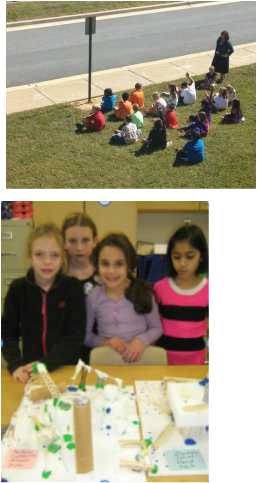
Engineers and Arborists
Each year third grade students learn about the role trees play in our ecosystem. The students learn how trees provide us with oxygen, food, medicine and shelter. The third graders learn about conservation efforts and become active members of tree conservation when they receive their own sapling to plant at home.
Our third graders become engineers in the fall. They are given the task to design a playground that students at our school would enjoy. During the construction of their model playgrounds they may only reused or recycled materials.
When the weather is nice, third grade learns math outdoors. Lessons have included a scavenger hunt for geometric shapes in nature, perimeter and area lessons using our fields, and estimation lessons using our front lawn.
Each year third grade students learn about the role trees play in our ecosystem. The students learn how trees provide us with oxygen, food, medicine and shelter. The third graders learn about conservation efforts and become active members of tree conservation when they receive their own sapling to plant at home.
Our third graders become engineers in the fall. They are given the task to design a playground that students at our school would enjoy. During the construction of their model playgrounds they may only reused or recycled materials.
When the weather is nice, third grade learns math outdoors. Lessons have included a scavenger hunt for geometric shapes in nature, perimeter and area lessons using our fields, and estimation lessons using our front lawn.
Fourth Grade
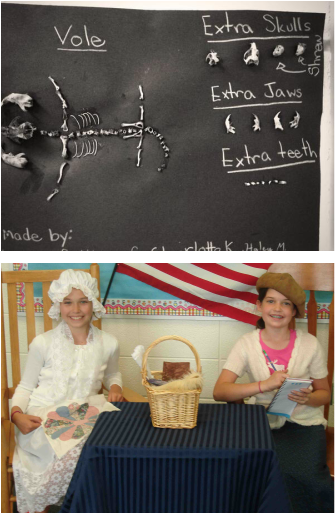
Habitat Researchers
Fourth graders have a real-life experience with the food chain. They dissect owl pellets to discover the food sources of owls. They use the evidence from their investigation to discuss and share their observations about consumer food chains.
Fourth graders learned a great deal about biomes this year in both Media and Science class. They used the research they gathered to write reports about how biomes impact the survival of the animals and plants living in that environment. They will then use that knowledge about biomes to complete an animal habitat unit in Media. The students will discuss how humans have impacted animal habitats and what we can do in the future to improve the lives of these animals.
Treasuring the Chesapeake with Mr. Tralka
The Chesapeake Bay is the largest estuary in the United States. It is one of Maryland’s most vital resources and is a complex ecosystem that includes many different habitats and food webs. The physical processes that drive the Chesapeake Bay ecosystem sustain the many habitats and organisms found there. Complex relationships exist among the living resources of the Bay watershed. All creatures, small and large, play a vital role in the overall health and production of the Bay. In this unit students will become experts on the physical, biological, economical, and historical aspects of the Bay. They will explore some of the current problems facing the Bay and review possible solutions. The goal of this unit is for students to develop a firm understanding of the problems and issues facing the Bay and to become actively involved in a minimum of one service project that will help to restore and protect it.
Fourth graders have a real-life experience with the food chain. They dissect owl pellets to discover the food sources of owls. They use the evidence from their investigation to discuss and share their observations about consumer food chains.
Fourth graders learned a great deal about biomes this year in both Media and Science class. They used the research they gathered to write reports about how biomes impact the survival of the animals and plants living in that environment. They will then use that knowledge about biomes to complete an animal habitat unit in Media. The students will discuss how humans have impacted animal habitats and what we can do in the future to improve the lives of these animals.
Treasuring the Chesapeake with Mr. Tralka
The Chesapeake Bay is the largest estuary in the United States. It is one of Maryland’s most vital resources and is a complex ecosystem that includes many different habitats and food webs. The physical processes that drive the Chesapeake Bay ecosystem sustain the many habitats and organisms found there. Complex relationships exist among the living resources of the Bay watershed. All creatures, small and large, play a vital role in the overall health and production of the Bay. In this unit students will become experts on the physical, biological, economical, and historical aspects of the Bay. They will explore some of the current problems facing the Bay and review possible solutions. The goal of this unit is for students to develop a firm understanding of the problems and issues facing the Bay and to become actively involved in a minimum of one service project that will help to restore and protect it.
Fifth Grade
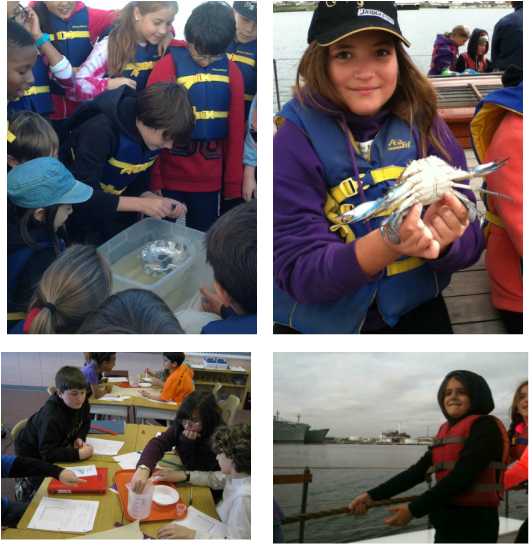
Water Conservationists
Living Classrooms Foundation provided unique hands-on, interdisciplinary and environmental education programs aboard historic ships with our fifth graders each year. These dynamic, "learning by doing" programs emphasize applied learning in math, science, social studies, language arts, and social skills. A one-day expeditions shipboard on the Schooner, the Lady Maryland and the Skipjack, Sigsbee, participants see how academic skills are used in the real world. Leadership and teamwork are key objectives as students work together to raise and lower sails, trawl for marine life, perform scientific tests, and explore the commerce, history, natural resources, and ecosystems of the Chesapeake Bay.
In Technology class, students complete the Bayville Unit which develops students understanding of the Chesapeake Bay. They identify components of the Chesapeake Bay ecosystems as well as the human activities involving the bay. Students continue to expand their understanding of the Chesapeake Bay with a research project conducting in Science and Media. The students develop an inquiry question related to the human impact on the health of the Chesapeake Bay and then conduct research to investigate the possible solutions.
Learning about Oceans with Mrs. Jensen
Oceans cover most of our planet’s surface and the scientific community has estimated that we have only 10% of ocean research completed. Our students, the scientists of tomorrow, will likely see ocean studies as the new frontier. The ocean systems unit is designed to put students in the role of oceanographers to explore the idea of the interdependence of systems of the ocean: the biological system, the chemical system, the geological system, and the Physical system. Students work collaboratively as scientific research teams, each focusing on an area of science reflected in the ocean systems. A final group project to complete a study of an identified “problem” in an assigned ocean environment tests students’ knowledge of all that they have learned.
More CEU Units listed below
| green_school_activities2.docx | |
| File Size: | 121 kb |
| File Type: | docx |
School-Wide Environmental Behavior Changes
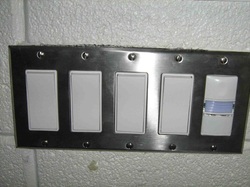
Energy Saving Light Switches- In 2013-2014 the school installed energy saving light switches with motion sensors. The sensors will automatically shut off the lights after sensing no motion in the room after approximately fifteen minutes.

Electronic communication within the school between staff- The administrators use Electronic Bear Facts to communicate with staff on a daily basis. Electronic plan books and use of the Google Documents has allowed teachers to plan effectively using technology instead of paper.

Bushy Parks PTA - Significantly reduced our paper communications by using an electronic PTA newsletter, e-alerts, and the PTA website to further communications as well as use these vehicles as sign ups to programs. The PTA also uses "Volunteerspot" in order to have parents volunteer in the school.
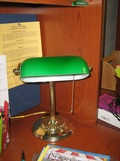
Teacher Desk Lamps- Before students arrive and after the students leave, teachers rely on teacher desk lamps to provide necessary light for their planning and grading. We are using over 80 teacher desk lamps through out the building which reduces the use of overhead lighting in our school.
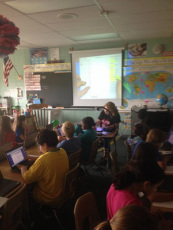
Computer Labs- Many teachers are choosing to use mobile labs instead of paper and pencil in the classroom. We have four mobile labs that teachers can wheel into their classroom which saves paper waste as well as engage the learners at the same time.
School Newsletter- The school communicates with the community using the Bushy Tales, an electronic newsletter sent to parents. This newsletter averages five pages. If we sent a paper copy home to each family we would be using 2,250 pages every other week just for the Bushy Tales!
| bushybeartalesmarch21_2014.pdf | |
| File Size: | 424 kb |
| File Type: | |
Professional Development
Two first grade teachers attended Environmental Workshops in 2013-14 sponsored by Robinson Nature Center and Howard County Conservancy. These workshops were titled Project WET (Nov. 9, 9-3:30), Project Wild (Feb. 1st, 9-3:30) and Project Learning Tree (Feb. 22nd, 9-3:30). Participants also received books and materials for use in the classroom.
Our pre-kindergaten teeacher participated in Growing Up Wild (Jan. 11th, 9-12:30). She also received a curriculum for the classroom which she has incorporated this year with her students and shared with team members.
Our art teacher Susan Weinstein is a certified Habitat Steward and has a yard certified as Wildlife Habitat from the National Wildlife Foundation. She often uses flowers from her gardens as subjects for student art.
Kathyrn Perry is our STEM representative and went to EEA training June 2013.
Angie Cole and Kathyrn Perry also took part in a MSDE cohort with Washington County in which they took a course entitled Life Science Animated. Information was shared with staff from these trainings in the fall each year.
Angie Cole received training from the Department of Natural Resources in October 2013 in order to raise Blue Gills in the Classroom.
Katherine Murphy participated a Chesapeake Bay Foundation Class for five days in August 2013 which was directed at Howard County's impact on the bay. Teaching STEM in the Local Environment, was intended to immerse Howard County educators in the diversity of the county watershed and the many aspects of daily life that impact the Chesapeake Bay.
| jennifer_lambros_green_pd.docx | |
| File Size: | 1581 kb |
| File Type: | docx |
| joy_hogan2.jpg | |
| File Size: | 354 kb |
| File Type: | jpg |
| joy_hogan3.jpg | |
| File Size: | 332 kb |
| File Type: | jpg |
| joy_hogan1.jpg | |
| File Size: | 538 kb |
| File Type: | jpg |
| dawn_martinec_green_pd.docx | |
| File Size: | 657 kb |
| File Type: | docx |
| stem_staff_oct21.pptx | |
| File Size: | 4326 kb |
| File Type: | pptx |
| angie_cole_pd.docx | |
| File Size: | 761 kb |
| File Type: | docx |
| katy_perry_pd.docx | |
| File Size: | 4099 kb |
| File Type: | docx |
| katie_murphy_pd.docx | |
| File Size: | 115 kb |
| File Type: | docx |
Celebration
Cultural Arts is going green too!
These events were held for all students at Bushy Park Elementary.
These events were held for all students at Bushy Park Elementary.
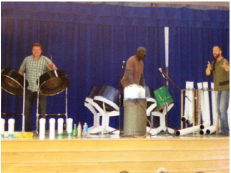
2011-2012 Oct. 2011 DishiBem G.R.O.W. Great Recycled Orchestra Workshop (http://yamd.org/artist/dishibem-g-r-o-w/)
G.R.O.W. is comprised of three artists from the Teaching Artist Institute; Kwame Opare, renowned African dancer; Kevin Martin, a musician with 20 years of experience with steel drums; and beat boxer Max Bent. Percussive dancer Matthew Olwell, rounds out the ensemble. G.R.O.W.’s mission is to educate students about the solid waste crisis facing the world today and inspire them, through performances and residencies, to take action in their own communities.
G.R.O.W. is comprised of three artists from the Teaching Artist Institute; Kwame Opare, renowned African dancer; Kevin Martin, a musician with 20 years of experience with steel drums; and beat boxer Max Bent. Percussive dancer Matthew Olwell, rounds out the ensemble. G.R.O.W.’s mission is to educate students about the solid waste crisis facing the world today and inspire them, through performances and residencies, to take action in their own communities.
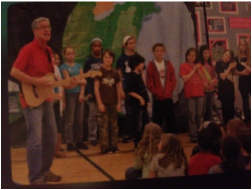
2012-2013 January 2013 Billy B http://billybproductions.com/
Through his energetic performances, Billy B. teaches children a large spectrum of environmental topics, from arthropods, alligators, and owls to complex scientific phenomena such as photosynthesis, pollination, the grinding of the earth’s tectonic plates, and erosion. In addition to teaching elementary children environmental science through song and dance, Billy B. also performs for primary and preschool students with both songs about nature and songs dealing with common courtesy, self help and life at school.
Through his energetic performances, Billy B. teaches children a large spectrum of environmental topics, from arthropods, alligators, and owls to complex scientific phenomena such as photosynthesis, pollination, the grinding of the earth’s tectonic plates, and erosion. In addition to teaching elementary children environmental science through song and dance, Billy B. also performs for primary and preschool students with both songs about nature and songs dealing with common courtesy, self help and life at school.
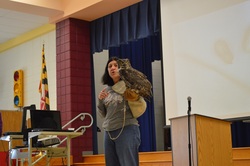
2013-2014 February 4, (rescheduled second day of workshops for March) Jennifer Keats Curtis -Children’s author Jennifer Keats Curtis wants to help bring children closer to the animals in their own backyards. By diligently researching her topic and interviewing real experts, including children working to help preserve and protect local wildlife, the long-time journalist has developed a knack for teaching young children about important ecological issues and what they can do to help. Author visit focused on researching and writing about animals including animal rescue and conservation. We also had an owl conservationist with a live owl as part of the assembly. Mrs. Curtis taught writer's workshops with our second graders also.
